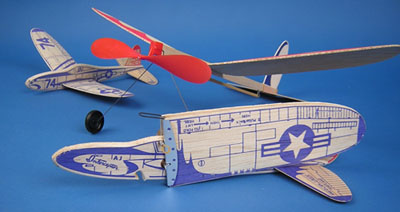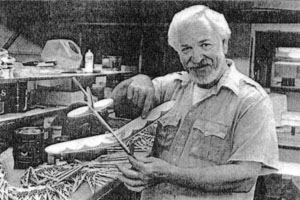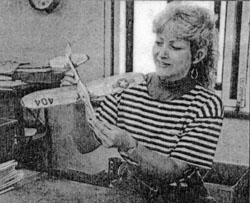
Frank Macy in Production of American Junior Models,
A Factory Tour from 1989
Take a tour with Frank Macy and his shop in Oak Grove, Oregon. A-J Models in production at the time were the 404 Interceptor, Hornet and "74" Fighter. |
||
Macy's Model Planes Captivate Young FliersStan Federman — The OregonianThursday, June 22, 1989 |
MILWAUKIE - A small, cluttered basement plant is filled with pieces of balsa wood and half-finished model airplanes. The room has a silk-screen machine and a router or two, and in the back, a tiny office with scribbled orders from dealers.
Something else is there, too, at this headquarters of the American Junior Aircraft Co. Enthusiasm - for the past, the present and the future. In the past, Portland engineering genius Jim Walker, father of the ready-to-fly concept of the then-infant model plane industry, owned and operated the company. Walker and his innovative models captured the fancy of youngsters throughout the Depression and World War II years. During the firm's lifetime, it sold some 235 million planes and made Portland the capital of the model plane industry. After Walker died in 1958, the company eventually disappeared from the industry scene. But seven years ago, Frank Macy, a longtime model plane buff and aviation historian, acquired the patents and trademarks of the early firm and in 1986 started up the company again with the help of his partners, Gary Ison and Victor Wolf. "Jim was my first real-life hero, much bigger than Capt. Midnight or Superman," said Macy, 54.
"I wanted to revive the Jim Walker heritage of model planes and make it live anew," Macy said. "And this is what we are doing." The white-haired, ebullient Macy said he believes that "kids haven't changed much down through the years. They still love to play with planes." He said many of today's model plane flyers would become the pilots and astronauts of tomorrow, "But they still have to learn how a plane flies, discover the basics of flight. What better way for them to begin than with a model airplane?" Macy makes sure the plant turns out models that are "just like Jim Walker used to make." All models are handmade, still using balsa wood and featuring steam-formed wings. They are easy to assemble and ready to fly within 60 seconds. Macy said balsa wood is lightweight, durable and repairable. Should a plane break upon landing, he said, some instant glue will immediately repair it.  The models sell for $3 to $11 and include a history of each plane. They are available from Portland hobby shops and nationwide on a mail order basis. The three top models are Walker's classic "74" Glider, which has movable wings; the 404 Interceptor, which is shot into the air with a rubber band; and the Hornet, whose propeller is wound up with a rubber band and takes off from the ground. Other favorites are a U.S. Navy Blue Angels glider and the folding wing, fluorescent Fire Hawk with a birdlike nose and fuselage. Macy constantly experiments with new models, including the Challenger space shuttle and a strange-looking flying saucer. The basement plant is next to the Oak Grove Elementary School playground. "We always get a lot of youngsters coming in, volunteering to be our test pilots," Macy said, laughing. In the rear of the plant, is a room that houses the American Junior Aircraft Historical Society. Here Macy shows visitors the society's growing collection of early model planes, several of them Walker-made, dating back to the early 1930s. He hopes one day to establish a model plane museum in the Portland area: "One where we can really help educate youngsters about aviation and the basics of flight. That's our dream for the future." |
Home | Jim Walker | FireWire | Air Mail | Workshop | Fireball | Firebaby

